PSV Eindhoven is on the brink of clinching the Eredivisie title. After 31 matches, they have 84 points and a nine-point lead over their closest rival, Feyenoord. With only three matches remaining, a draw against Sparta Rotterdam in the upcoming fixture would be sufficient to secure the league title for the first time since the 2017/18 season.
On the offensive front, PSV Eindhoven stand out as the strongest attacking force, having scored 103 goals, while their closest competitor, Feyenoord, rank second with 80 goals scored at the time of writing. Concerning defensive performance, PSV Eindhoven boasts the strongest defensive line, having conceded only 17 goals, with a seven-goal difference compared to Feyenoord, who have conceded 24 goals, making PSV Eindhoven the best defensive line in terms of goals conceded.
Upon examining the statistics, it becomes apparent that PSV Eindhoven’s defensive prowess against set-pieces has been a significant factor in establishing them as the best defensive line. They are the only team in the Dutch league that has not conceded any goals from set-pieces thus far, holding a 5-goal advantage over Ajax, Feyenoord, Go Ahead Eagles, and Sparta Rotterdam, each of which has conceded five goals from set-pieces.
One of the reasons for their defensive excellence against set-pieces is their proficiency in defending corner kicks. They are also the only team that has not conceded any goals from corner kicks, with a two-goal advantage over Ajax and Sparta Rotterdam; both have conceded two goals from corner kicks. This tactical analysis will elucidate PSV Eindhoven’s defensive tactics against corner kicks, highlighting their strengths. Subsequently, we will discuss potential weaknesses that opponents could exploit.
The defending system
In the first photo below, we start with knowing their defending scheme at first, so it is clear that they defend with the hybrid system using five zonal defenders, three man markers, a short-option defender and a player ready to get the rebound on the edge of the box.
This is the main shape of the zonal defenders against probable in-swing crosses, but they depend on their best defender, André Ramalho Silva, to get the first touch, so he sometimes stands in front of the line as the second or the third zonal defender, at the goalmouth, as shown in the second and the third photos below. We think that depends on the possibility of sending the cross to the near or the far post, depending on the opponent.
In the fourth photo below, the shape of the zonal defenders against out-swing crosses is shown below, a little inclined outwards.
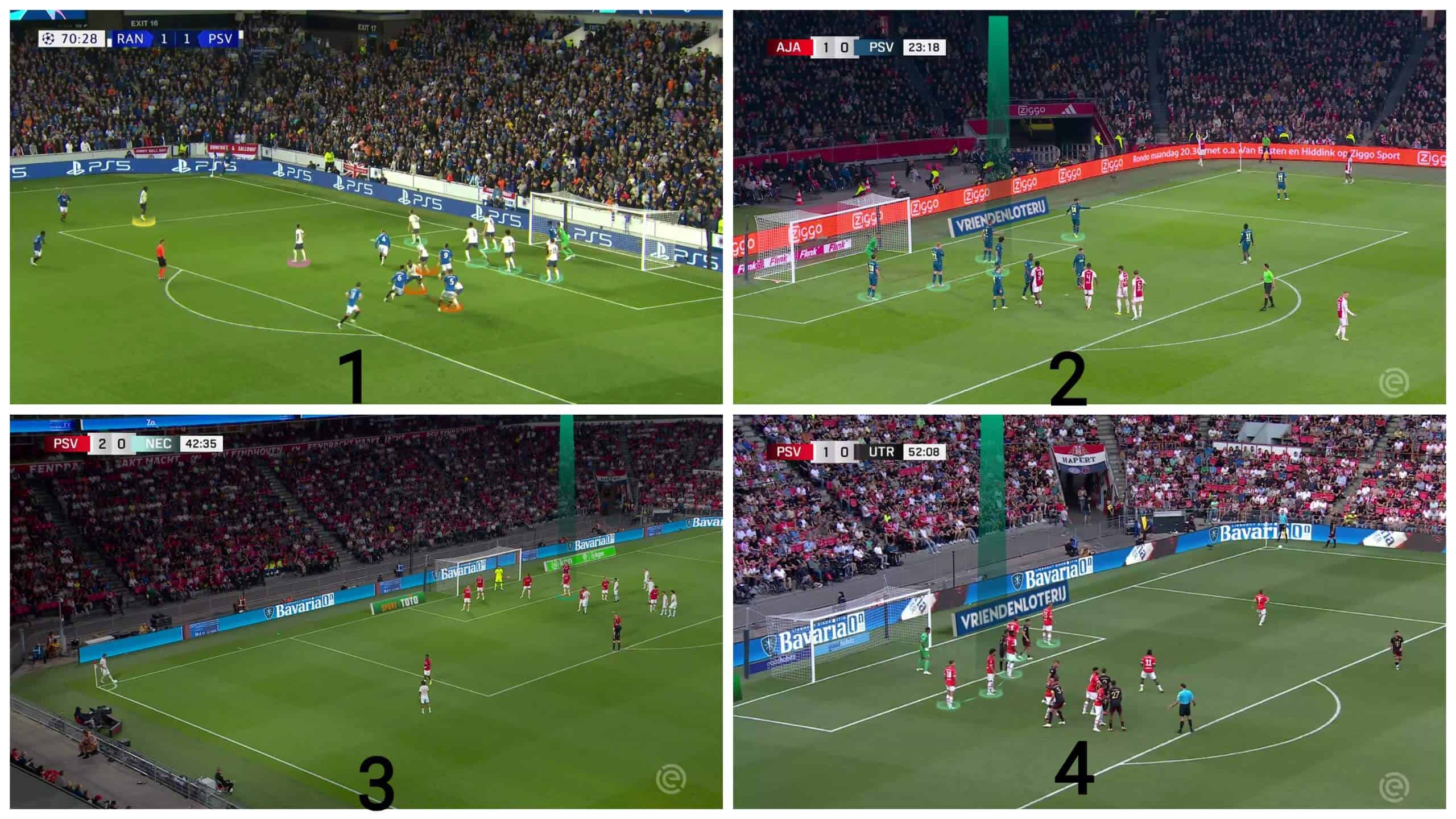
The same thing happens regarding André Ramalho Silva, who stands as the third zonal player in the last case, but he sometimes stands as the second one to clear the ball depending on the opponent’s most targeted area, as we believe, shown in the two photos below.
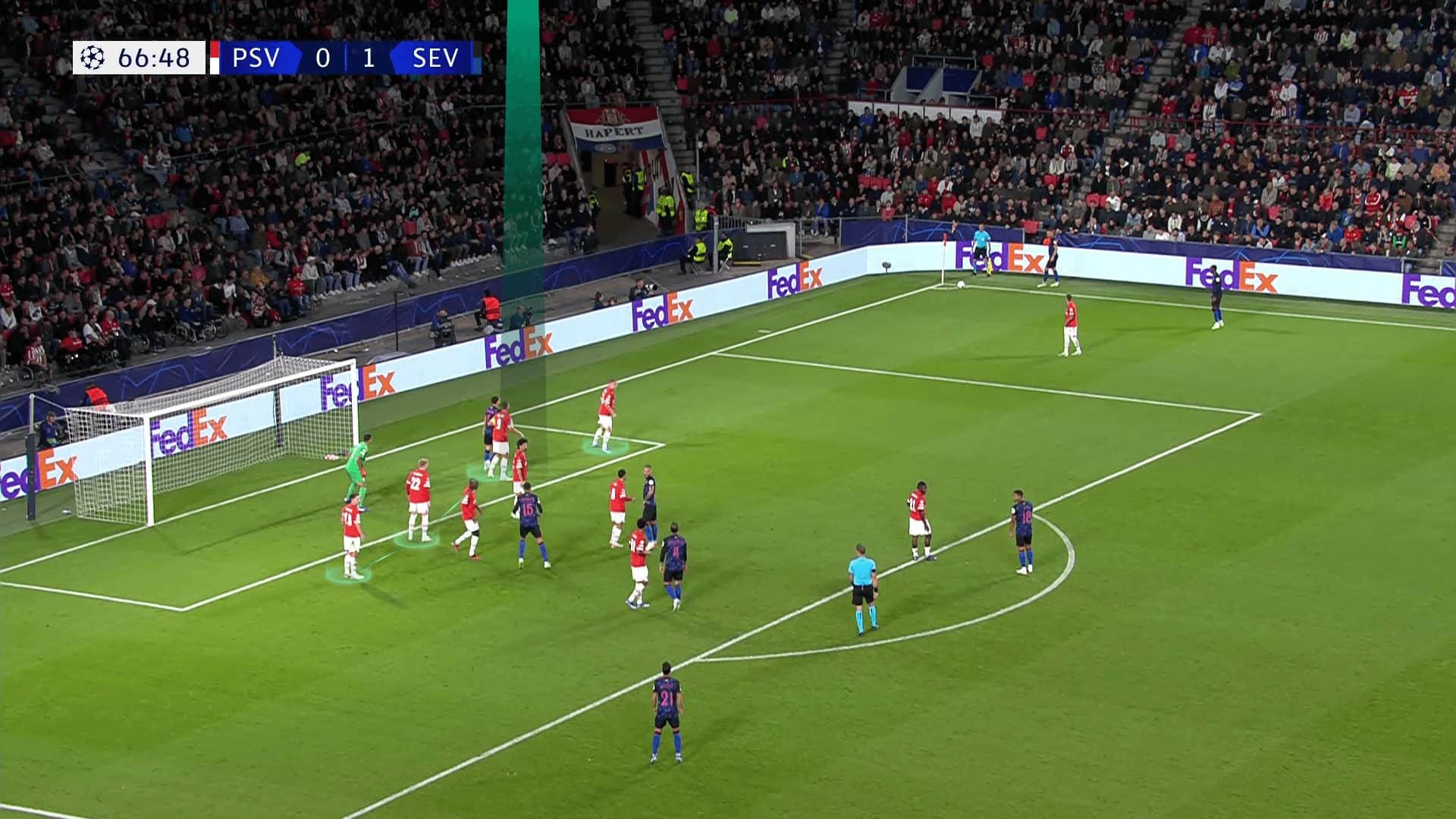
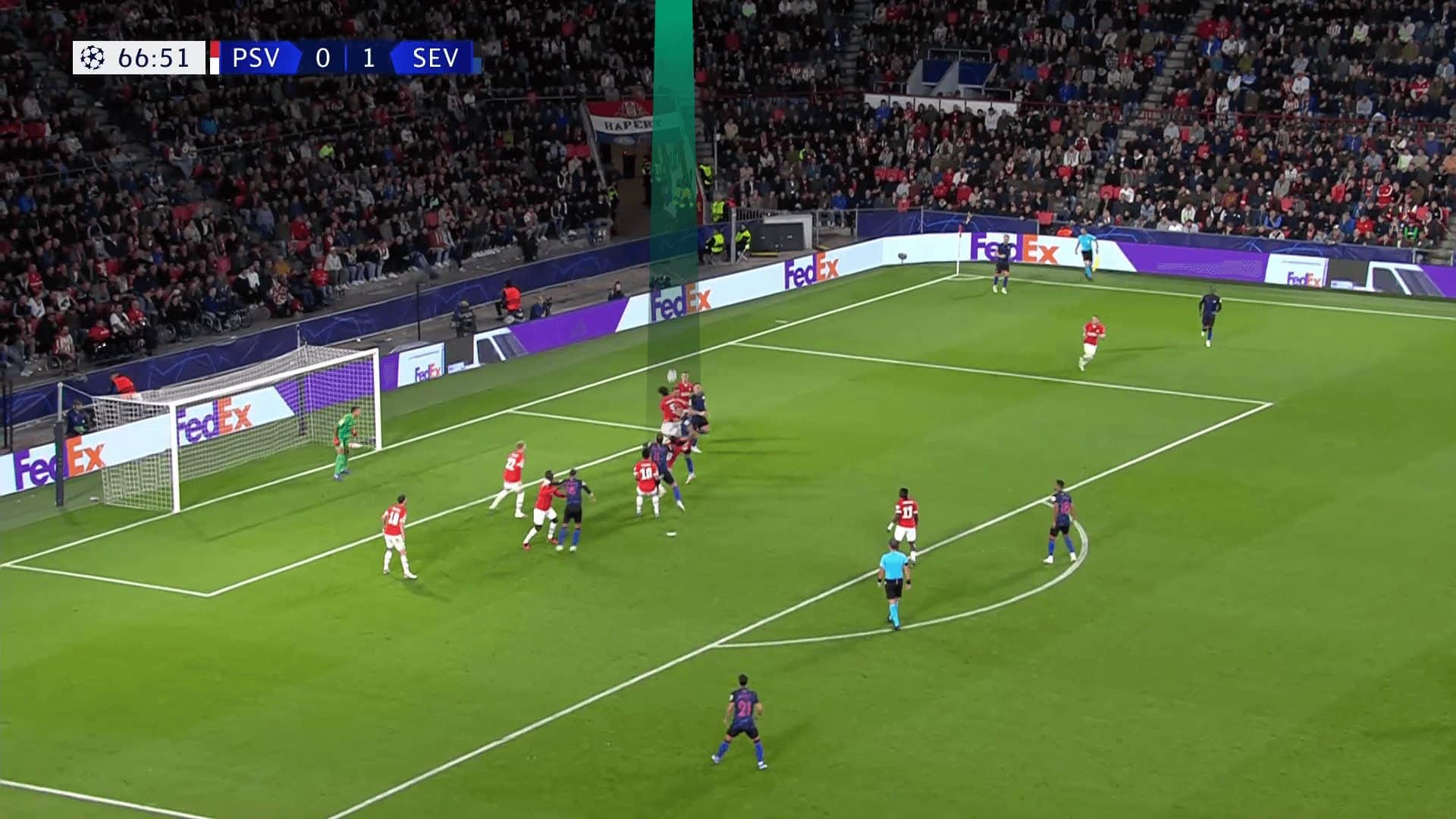
They also depend on the goalkeeper to claim any ball passing the six-yard to the far post, as shown in the first two photos. They also prefer not to mark the player who goes to block the goalkeeper, letting him deal with that, pushing the attacker and claiming the ball without any crowding around him, as shown in the third and fourth photos below.
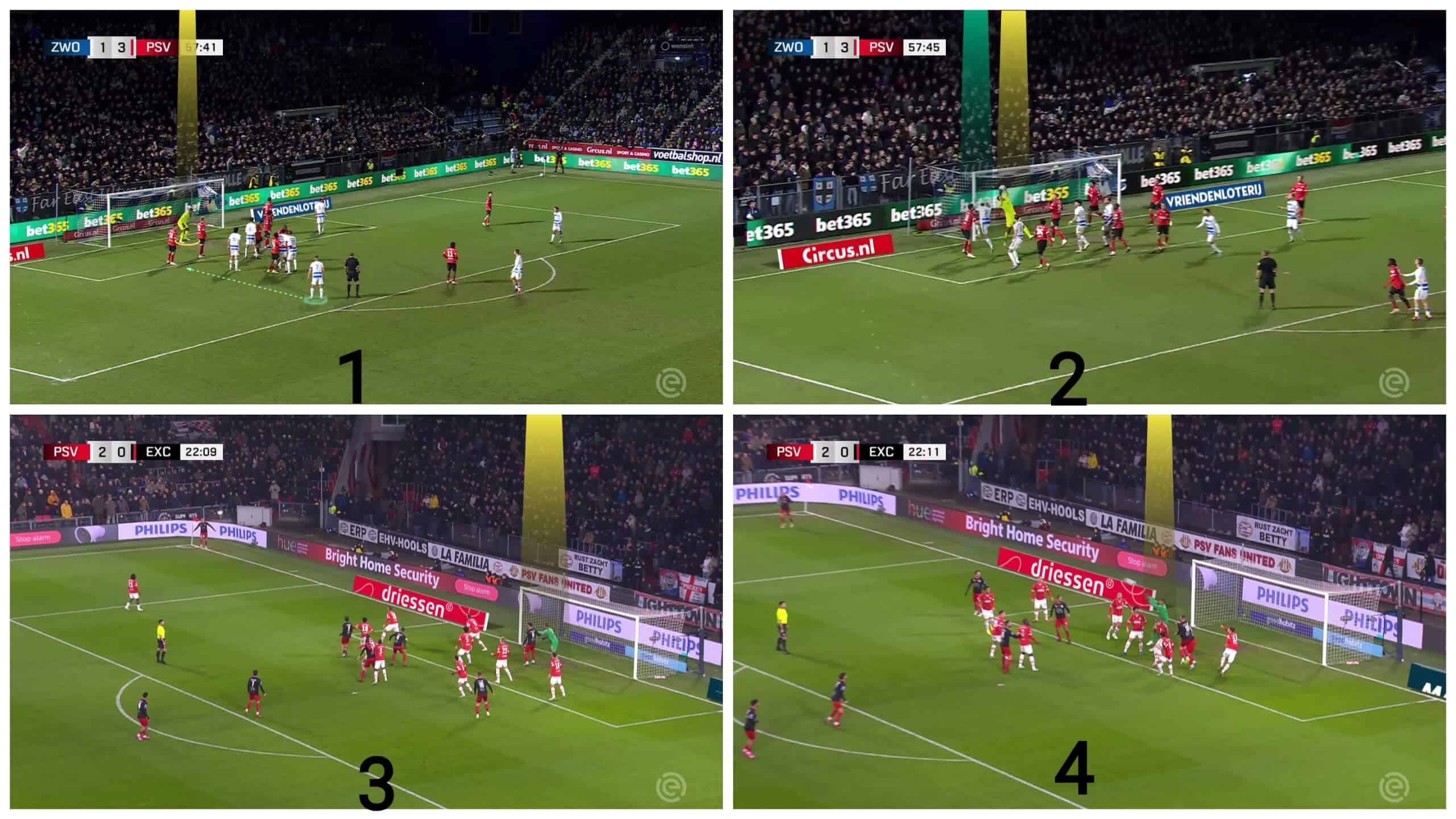
If that attacker is supposed to be marked with the three man markers because he is good at aerial duels, his marker, naturally, goes to mark him with no problem, as done with William Saliba in the photo below.
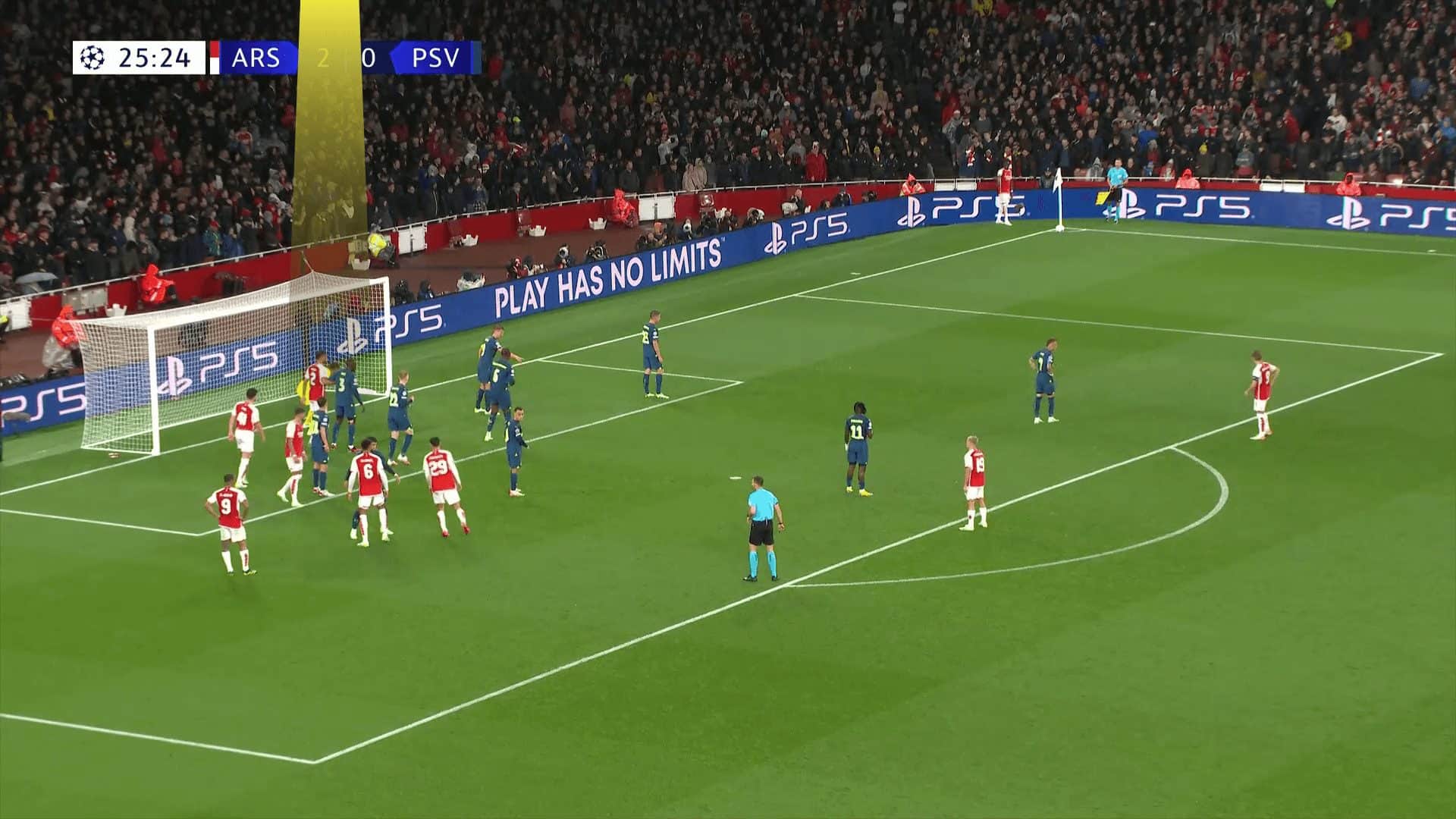
The second thing we should know is the double job of the zonal defender near the post who fills the gap behind the first zonal defender when he goes forward to defend flicks, so you can see below that the yellow attacker is free because there are only three man markers, one goes to the far post near the zonal line tracking his marker leaving the area around the penalty spot in a 3-v-2 situation. This free attacker targets this gap, but the zonal line has no gaps because of that shifting, as shown in the second photo below.
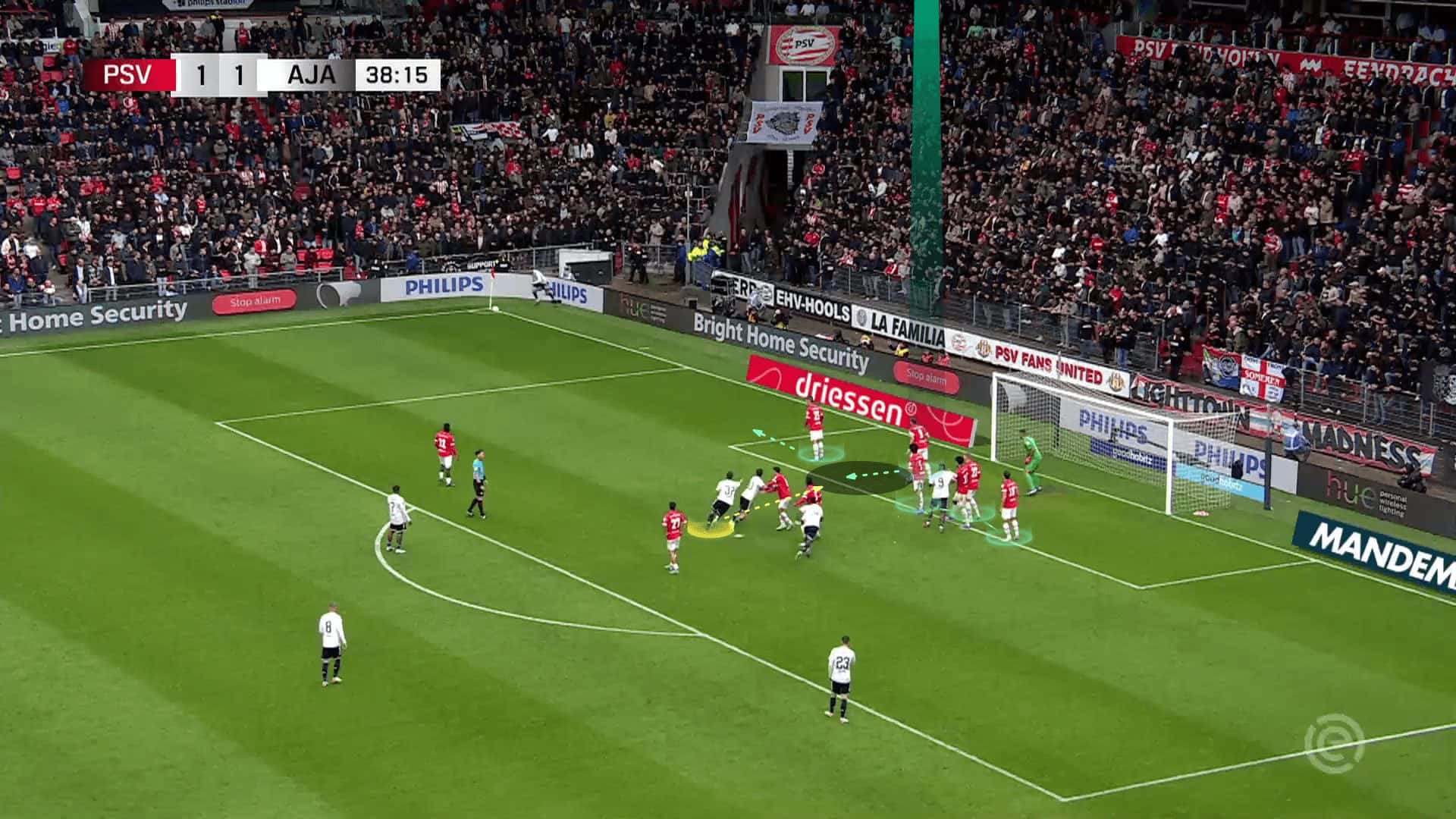
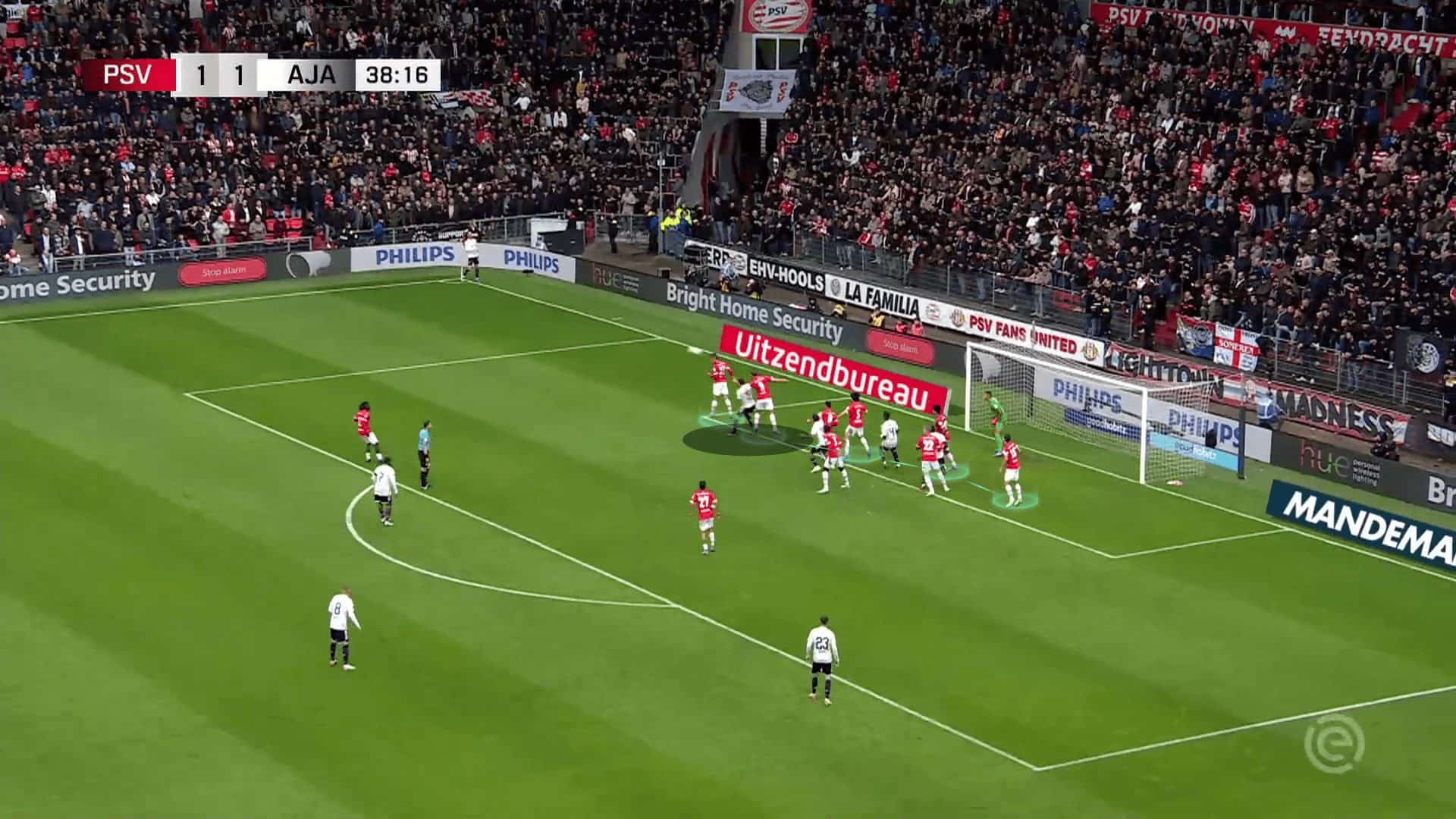
Strengths
It is so hard to break this hybrid system because if you are one of the best three attackers on the attacking team, you will have two obstacles to reach your destination: your man marker and the zonal defender at the targeted area. So attacking teams should plan for a full routine, not only old ways like targeting good players in good areas. We will discuss the probable scenarios for that.
In the first photo below, an attacker targets the area before the near post to flick the ball, but he faces the zonal defender and his marker, who keeps tracking him, as shown in the second photo below. You may say that there are only three man markers, so the attacking team can target a free player, and that is a good question, but the free layer is not one of the best three attackers, so he can’t overcome the zonal defender who usually has the priority to be the best defender, as shown in the third and fourth photos below.
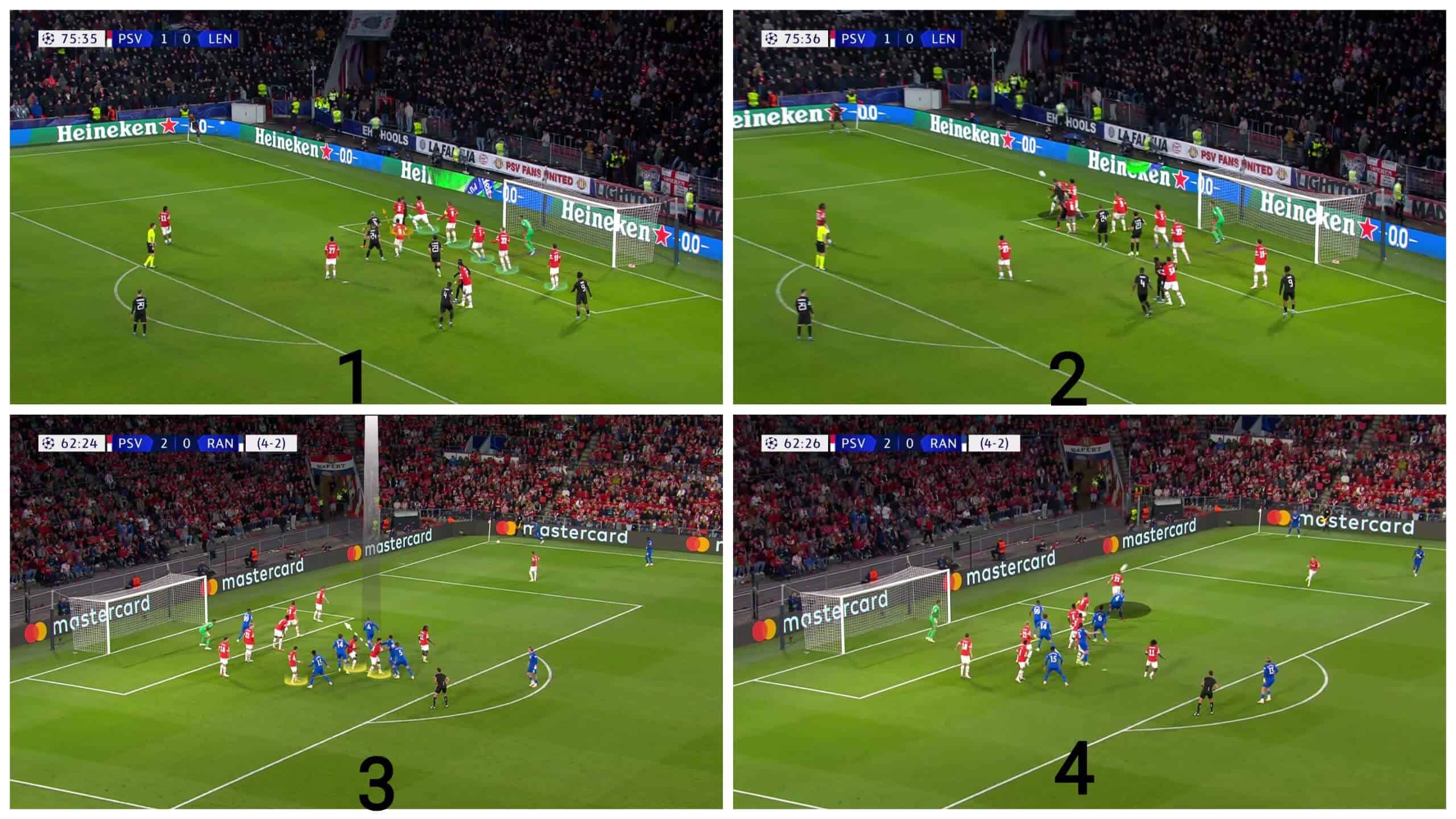
If the attacking team targets a good player in a far area, he will be far away from the zonal defenders, and this is right, but he should overcome the man markers, which puts us against two scenarios. The first one is losing the duel against the marker or losing control of the ball due to this conflict, as shown in the two photos below. The second scenario is having an excellent attacker like Sergio Ramos, in the third and fourth photos, who wins the duel against the marker, but from a far distance away from the zonal defenders, so it is so hard to lead to a chance.
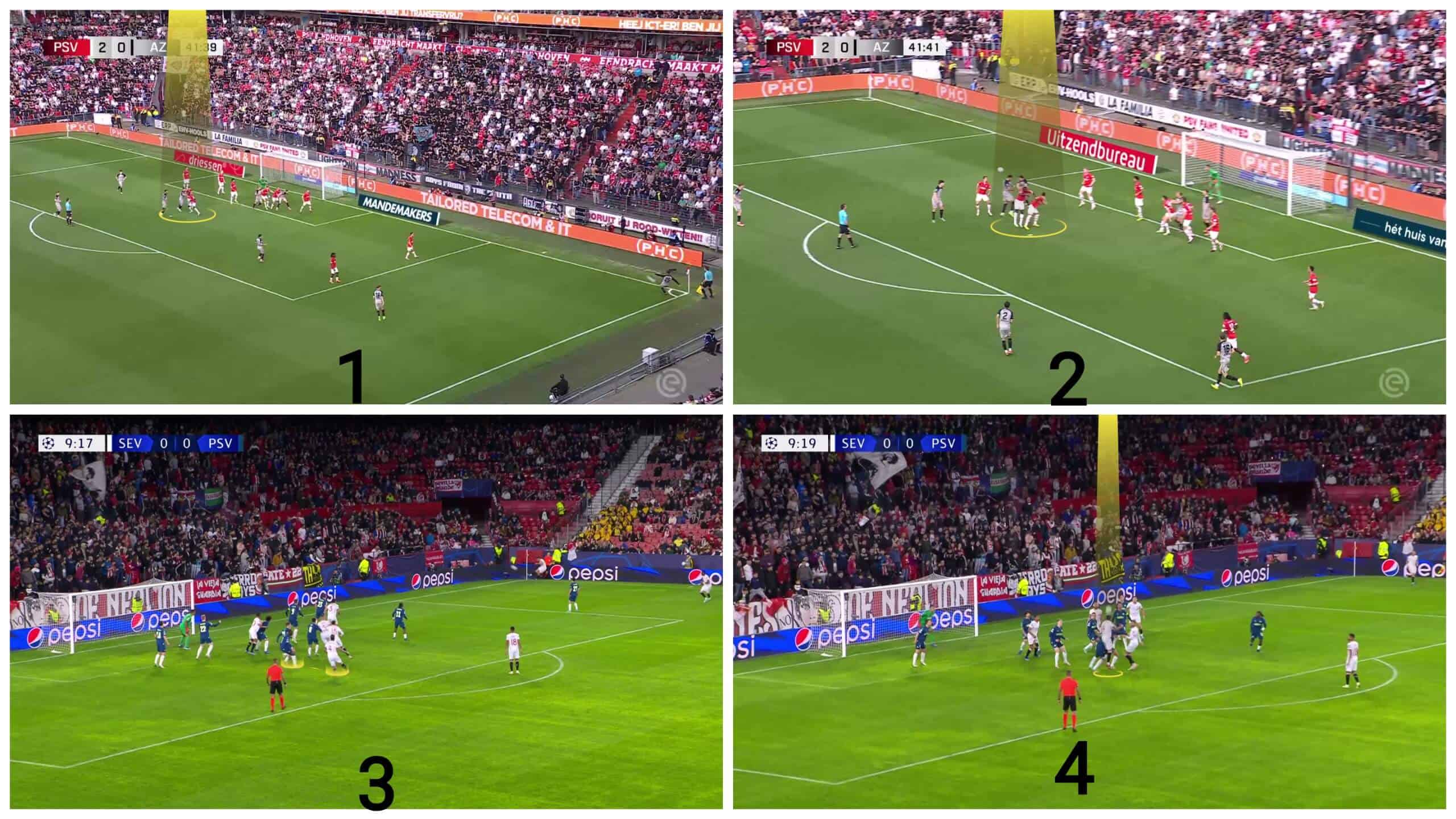
Regarding this idea of targeting good players in far areas from the zonal defenders, PSV deal with that by asking the zonal defenders near the landing area to go forward to clear the ball, helping the man markers, as shown in the two photos below.
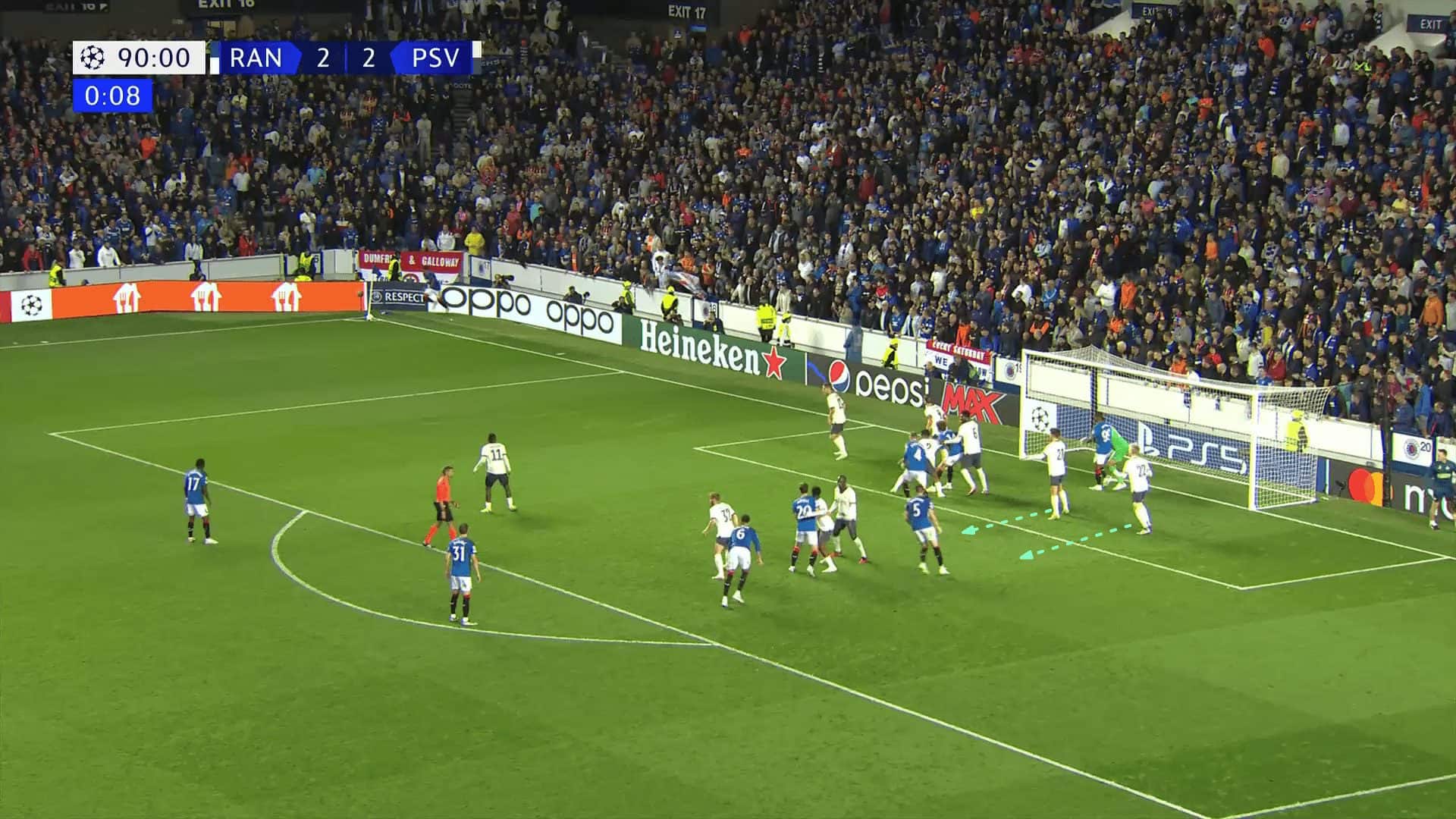
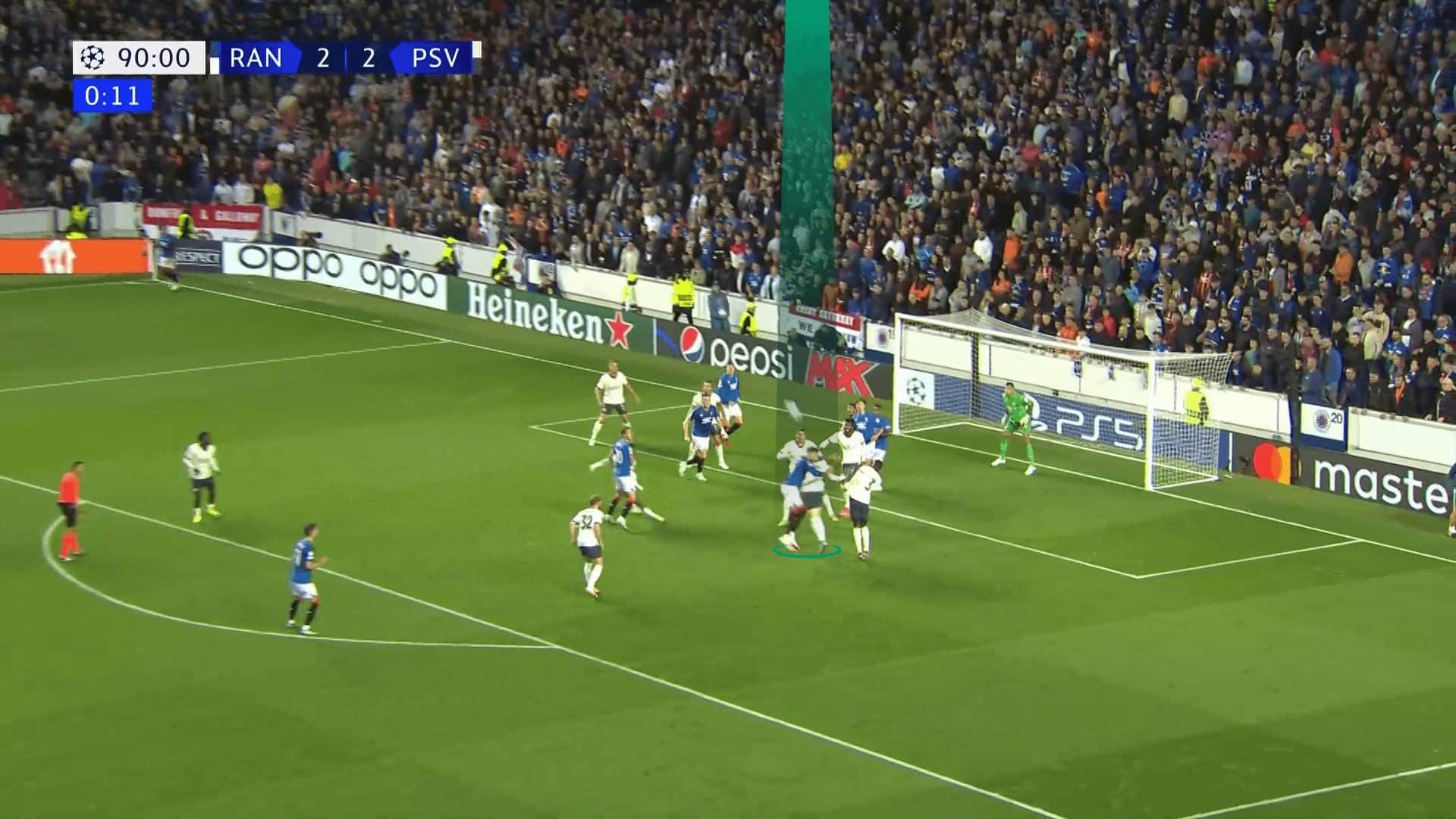
Weaknesses
We come to the second part, which explores how teams should deal with that system and explains the weaknesses PSV can improve to be ideal.
Starting from where we left off in the previous part, they have a problem when the zonal defenders push high to clear the ball, which is the first, and the last zonal defenders keep low, which cancels the off-side trap. As we will explain in detail, opponents can cause harm if they win the first touch.
In the first two photos below, the three middle zonal defenders push up to clear the ball near the penalty spot, but the first and the last zonal defenders keep low, which is dangerous if the opponent wins the first touch.
Coming to another example in the third photo below, the opponent overloads the area around the penalty spot with four attackers against two man markers; the third one keeps tracking an attacker in yellow to increase the possibility of winning the first touch with some other advantages like the out-swing floated cross which causes orientation problems for the markers who lose the communication with the attackers when they step toward the near post then going back, as shown in the fourth photo below.
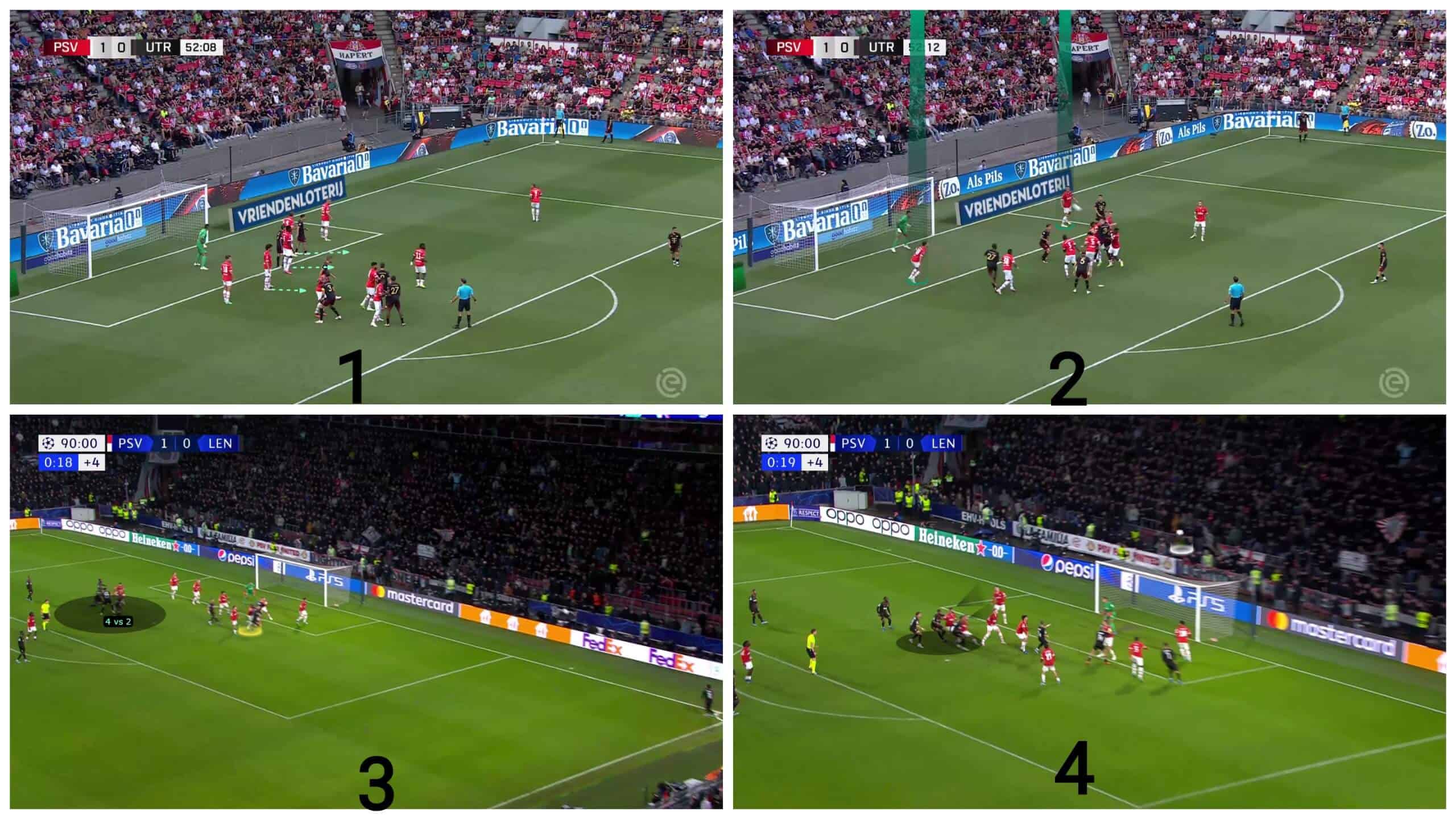
In the end, the attacking team wins the first touch, but from a far area, so we suggest exploiting that the yellow zonal defender covers the off-side trap with more attackers standing in the six-yard waiting for the headed pass, as Man City did in the coming case.
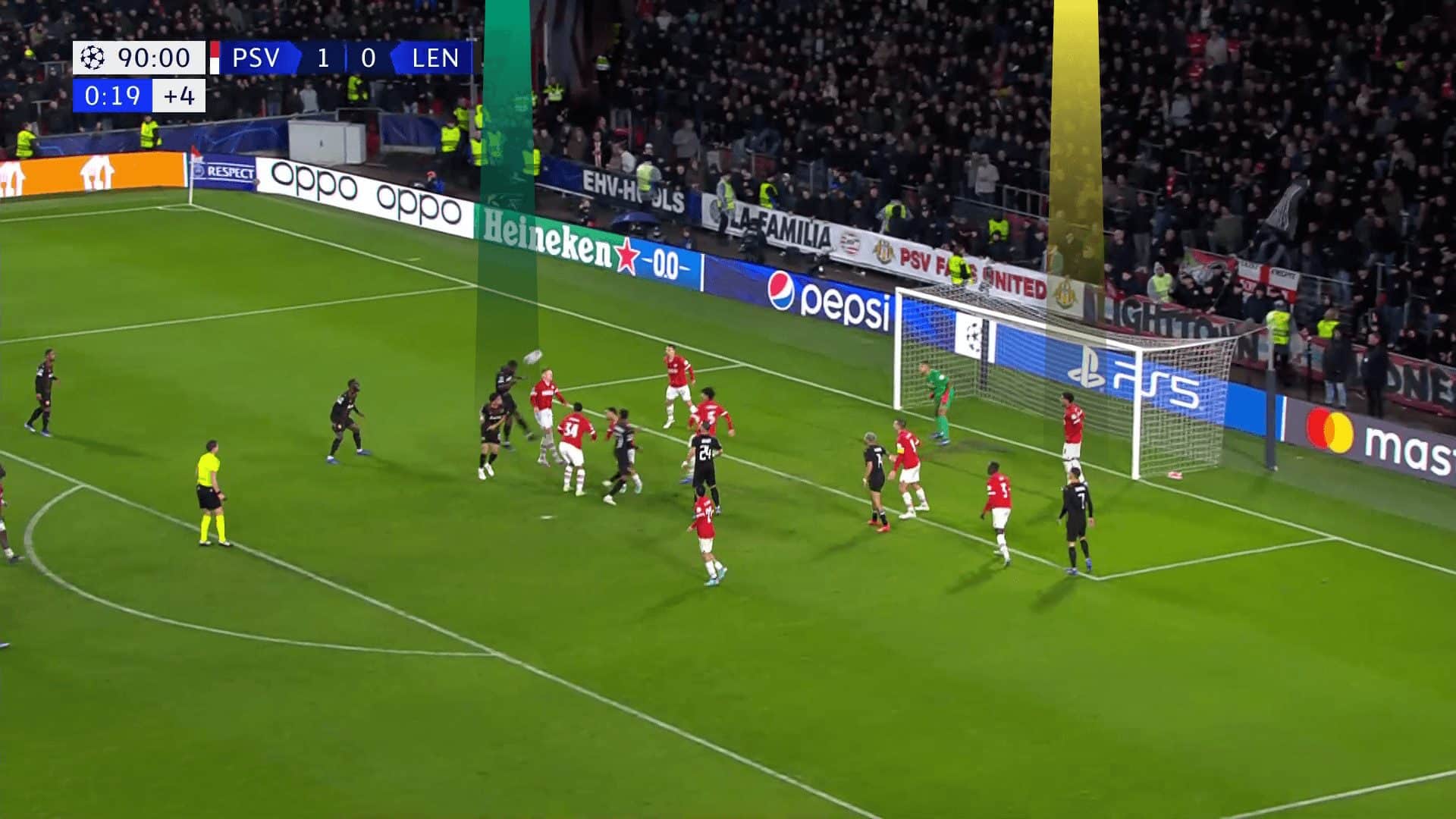
In this idea, attacking teams target a player without marking because he isn’t a good player at aerial duels, so opponents neglect him, using him only to nod the ball to an excellent player at aerial duels in a better and nearer area. At the same time, the defenders pay attention to the first head touch, forgetting the second targeted player at their back. Let’s explain in detail.
In the first photo, Man City use this idea by the principle of underloading against RB Leipzig’s four man-markers by targeting Bernardo Silva, who is free coming from the near post because he isn’t a dangerous player at aerial duels, so no one focuses on him while the other four attackers are unloading the targeted area for him dragging the man-markers with them, as in the second photo.
In the third photo, five attackers are framing the goal. Rodri blocks the zonal player in the middle to isolate the three attackers behind him against only the last zonal defender. At the same time, another drops back, standing on the line beside the goalkeeper, covering the off-side. Two attackers take the attention to free Erling Haaland behind him, who gets the headed pass, and the result is a goal, as in the fourth photo.
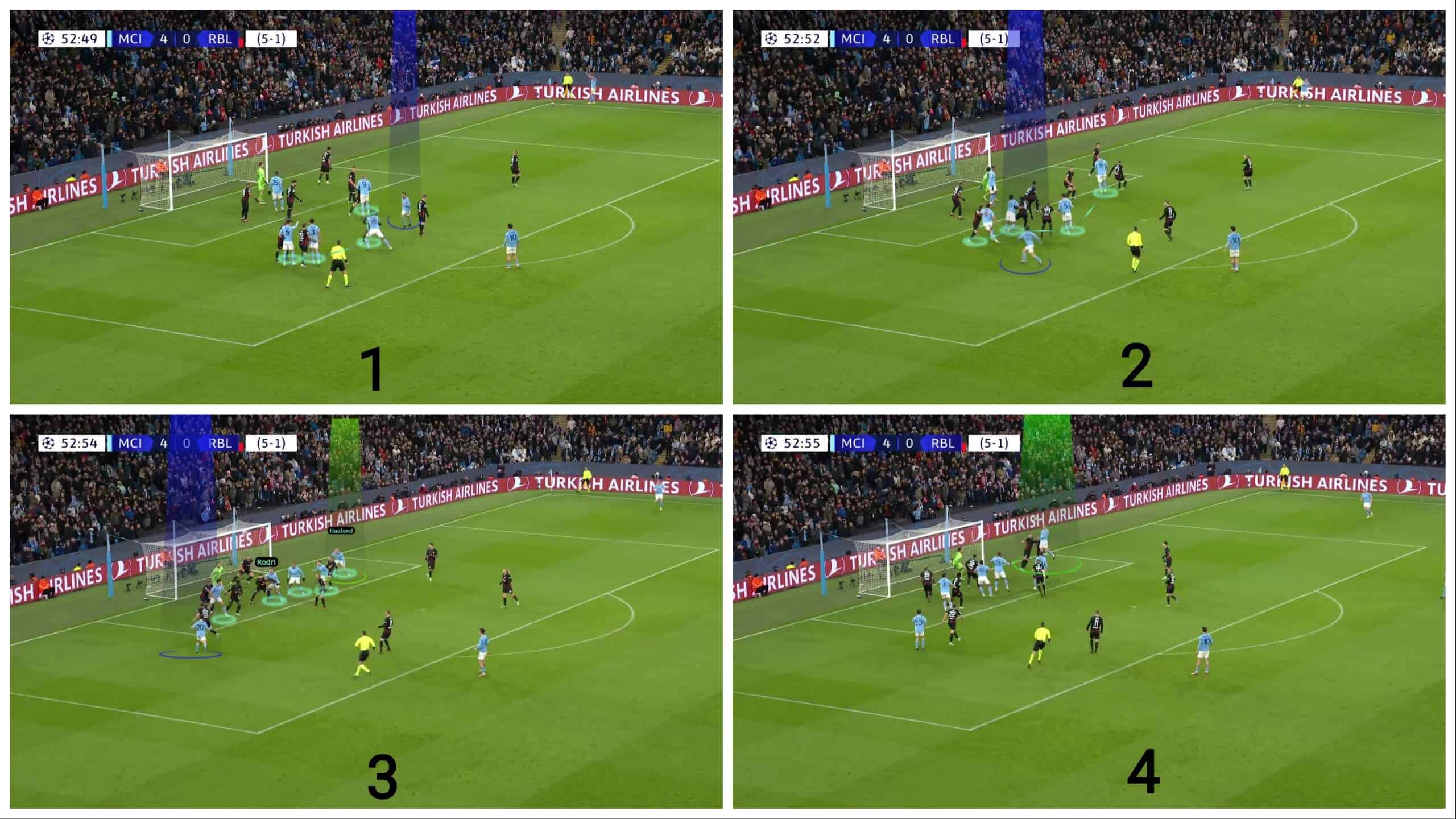
The second probable weakness is the area inside the six-yard on the near post in case of out-swing crosses. They sometimes exaggerate in standing inclined outwards with no defender inside the six-yard, as shown below, which could be exploited, especially on the near post.
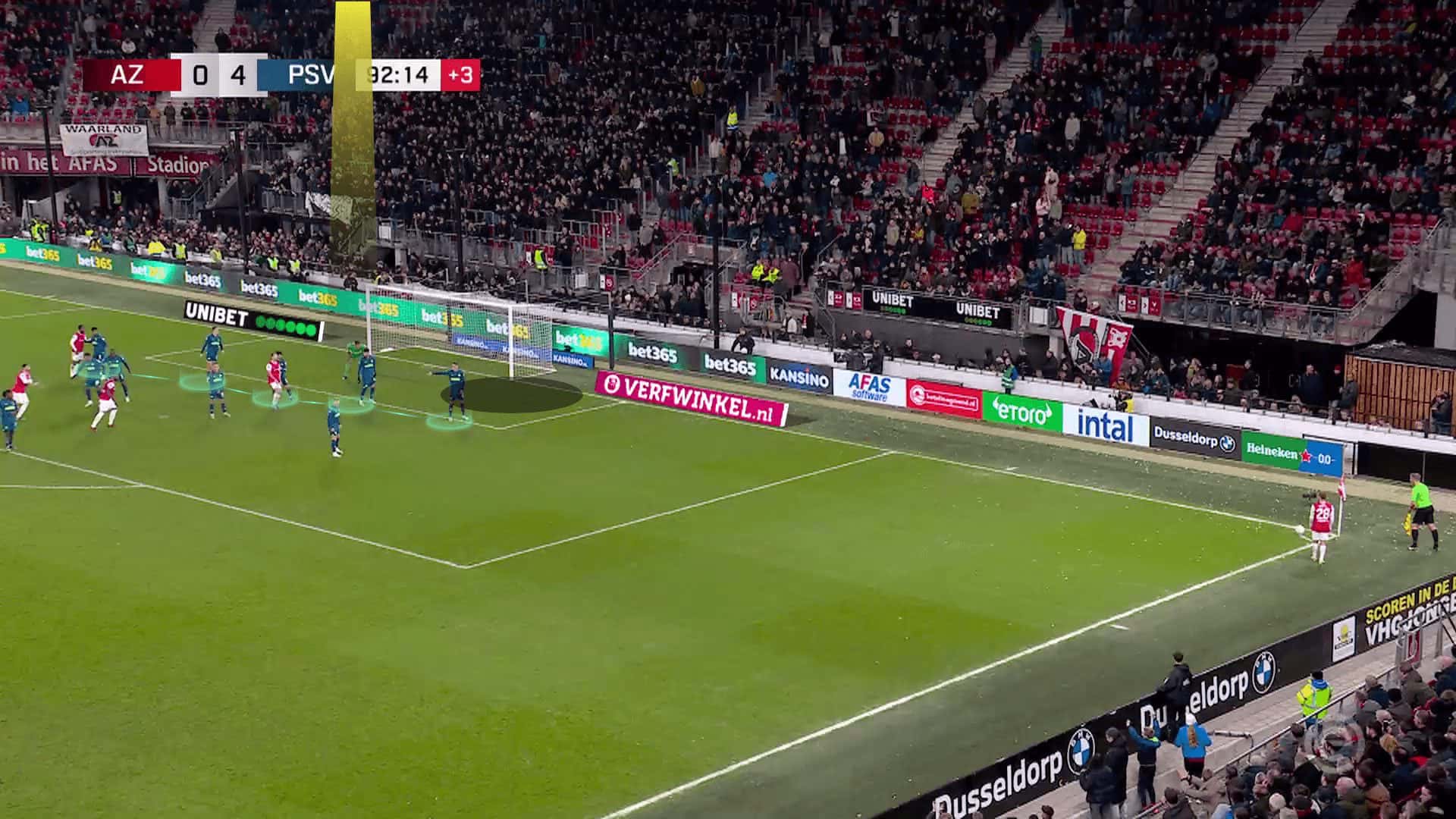
As evidence, Man City did this against Liverpool weeks ago. As shown below, Liverpool’s five zonal defenders are highlighted in green, with only the first zonal defender in the six-yard, leaving ample space between him and the near post, which is the targeted area. The first thing is that Rodri, in white, moves to the area before the near post to drag the green-arrowed zonal defender with him, leaving only the first zonal player, Alexis Mac Allister, at the targeted area. Here, the mission of Nathan Aké, in pink, is to block Mac Allister from the back to free the targeted area for John Stones, in yellow, who stands among the zonal defenders without marking coming from Mac Allister’s back, as shown in the two following photos.
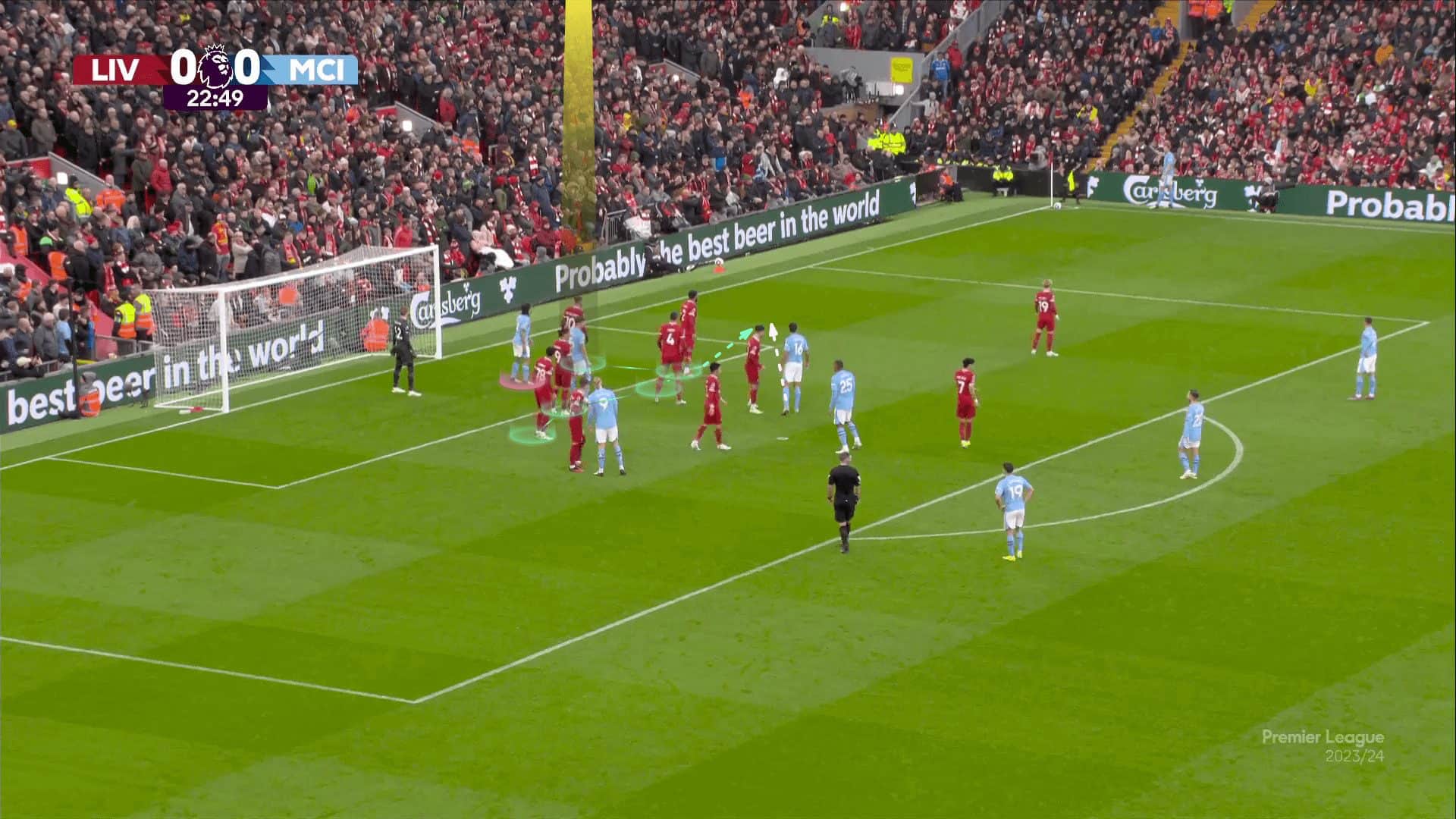
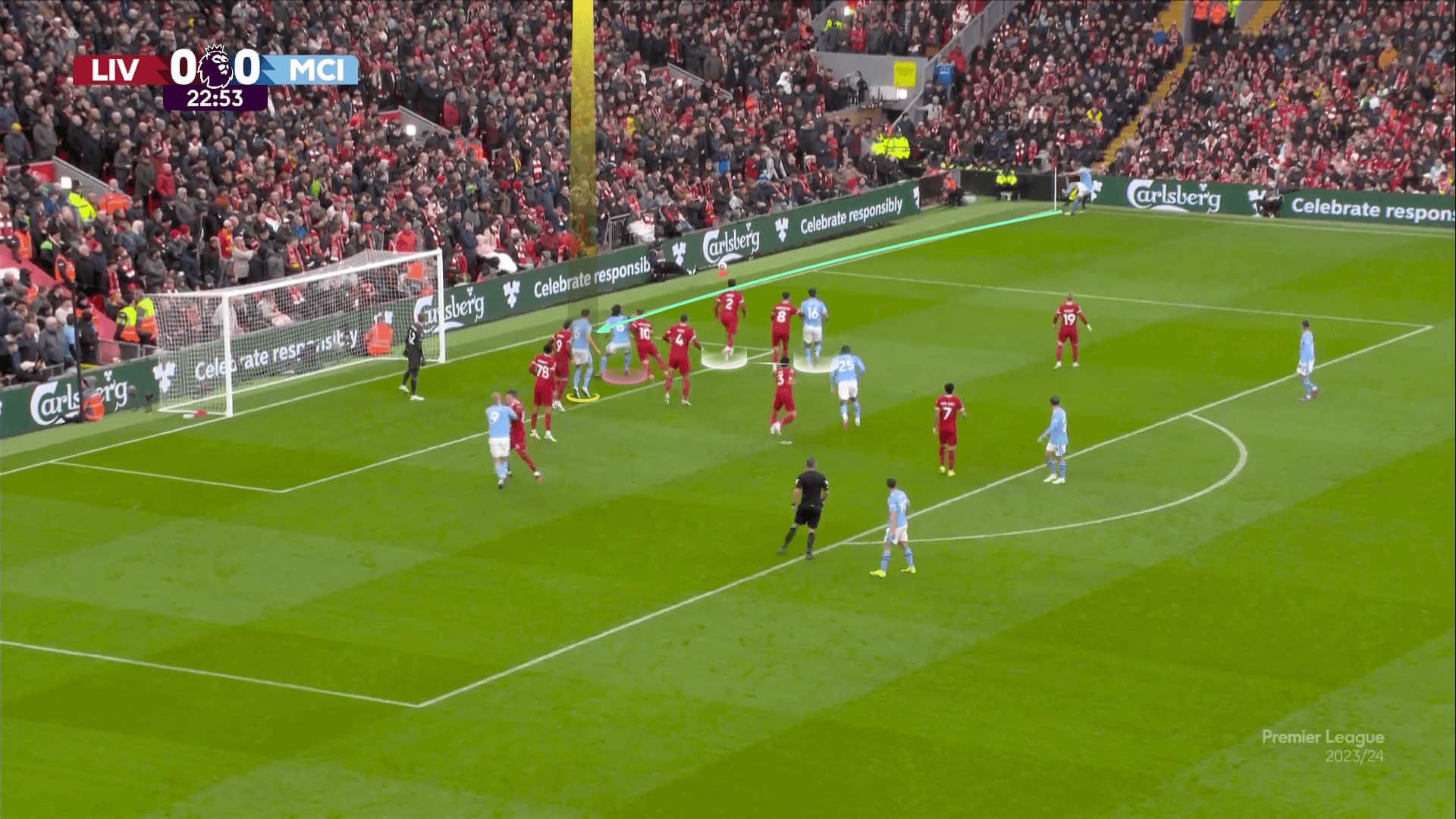
The plan works, so Stones receives the ball, scoring an important goal, as shown below.
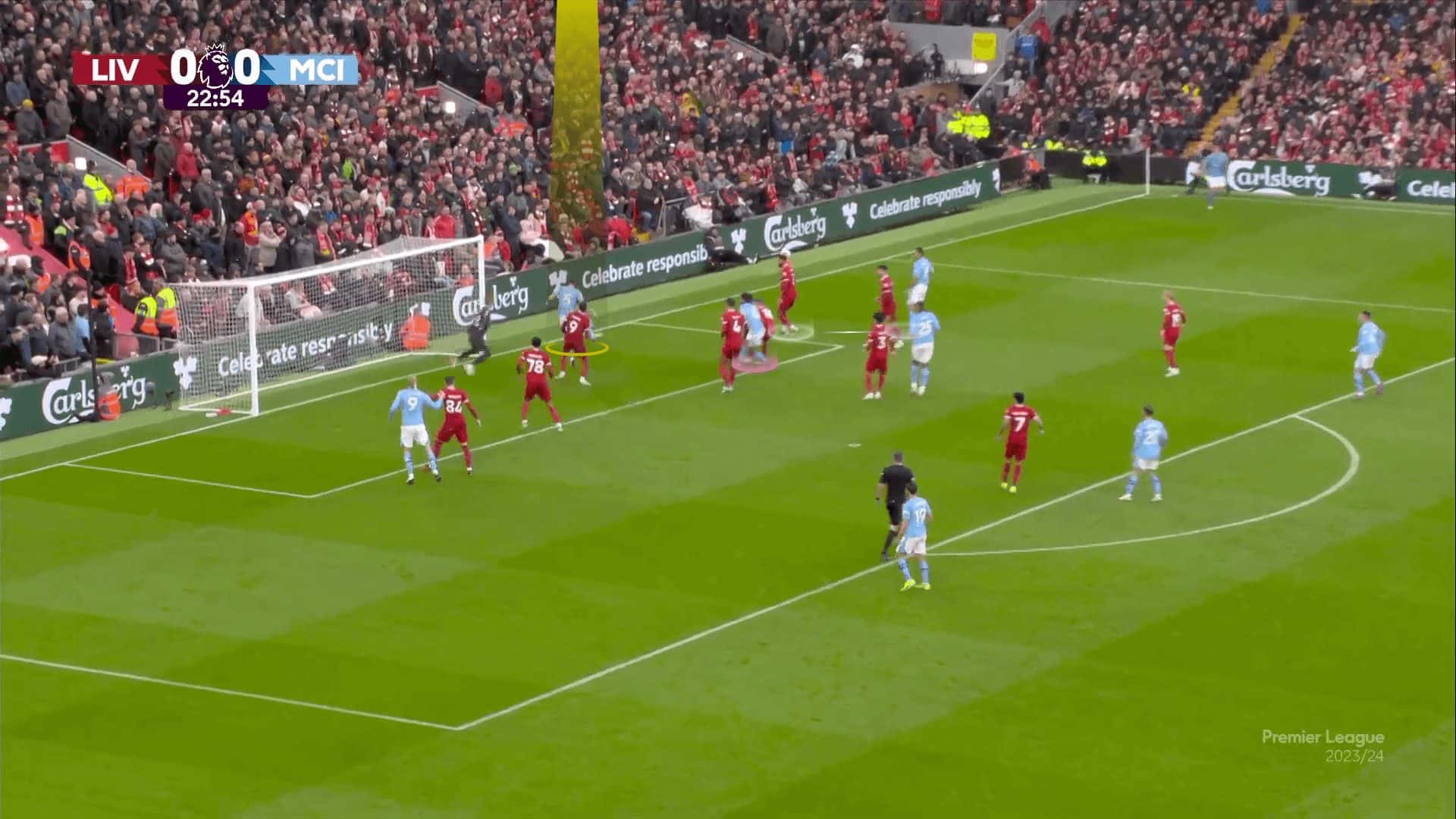
The third weakness is dealing with short corners, leaving the edge of the box empty. As shown below, the short-option defender should be helped by the first zonal defender after playing the short corner to avoid the expected 2-v-1 situation. This becomes more difficult when the short-option attacker starts so close that makes it longer for the zonal defender to come. In the second photo, the opponent makes it harder by using a third attacker coming from the back to receive the ball. At the same time, the zonal defender is still late so he can receive in a large area, sending a dangerous cross, as shown in the third and fourth photos.
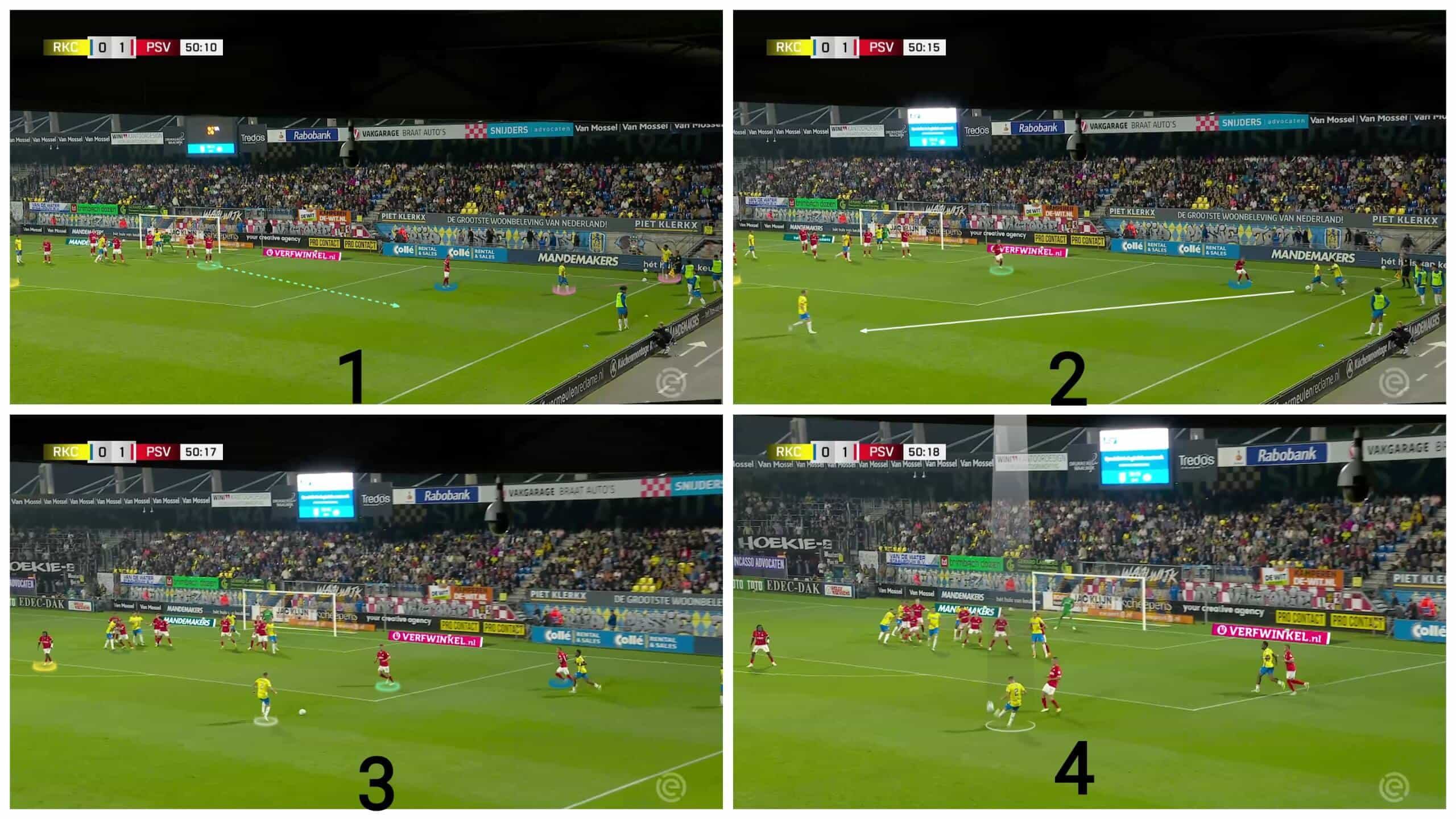
This causes the rebound defender to leave the edge on the box, helping to quickly empty the rebound zone, as shown in the two photos below, but it wasn’t exploited.
Coming to another case in the third and fourth photos, a man marker fills this gap going to the edge of the box, but the opponent overloads the short and rebound areas, so he becomes against two possibilities: going to help or stay with the attacker on the edge of the box.
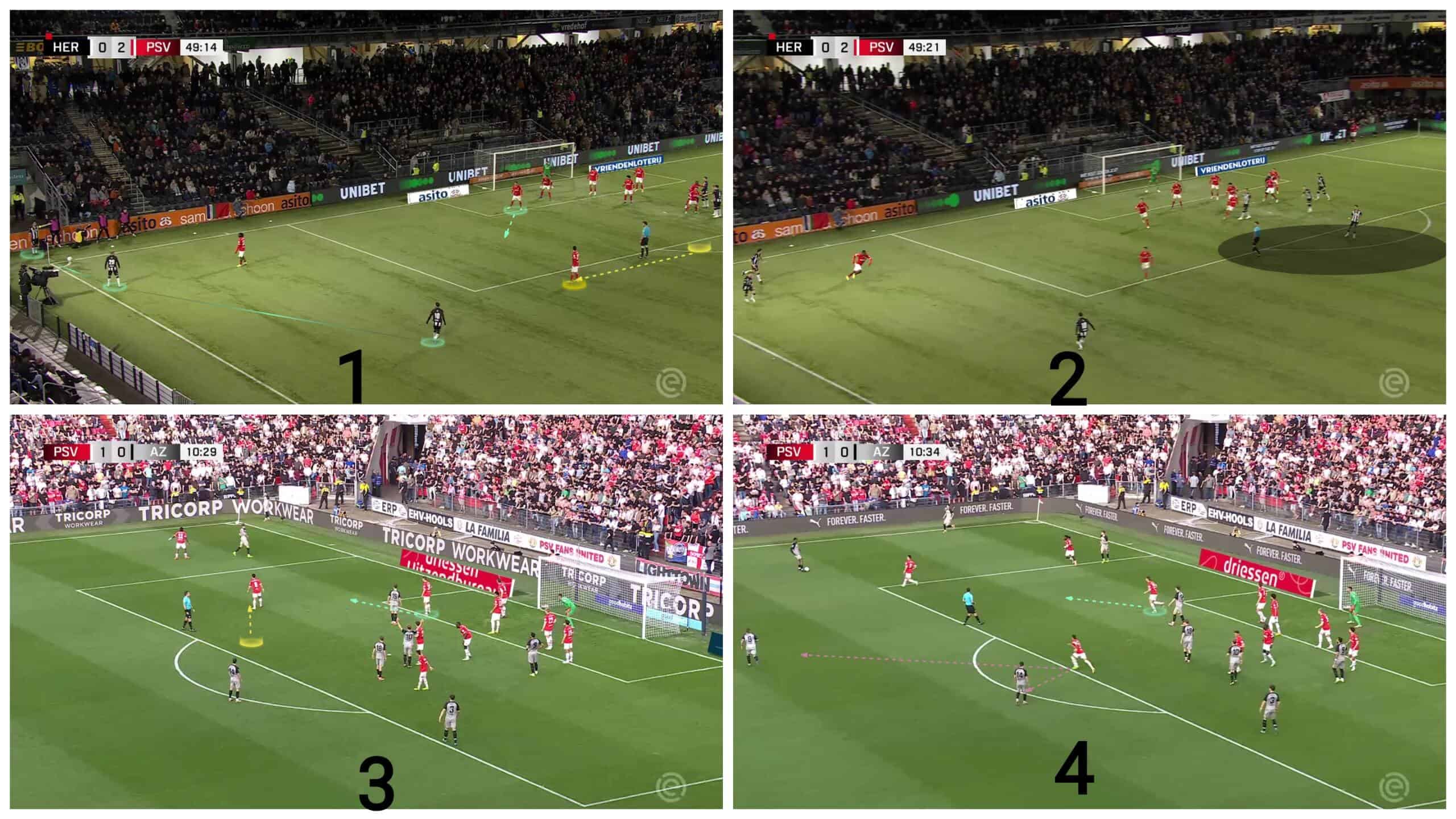
This player, in pink, chooses to help leave the shown area empty, but it isn’t exploited, as shown below. It is clear that they don’t give priority to protecting the rebound zone, but no one exploited that enough.
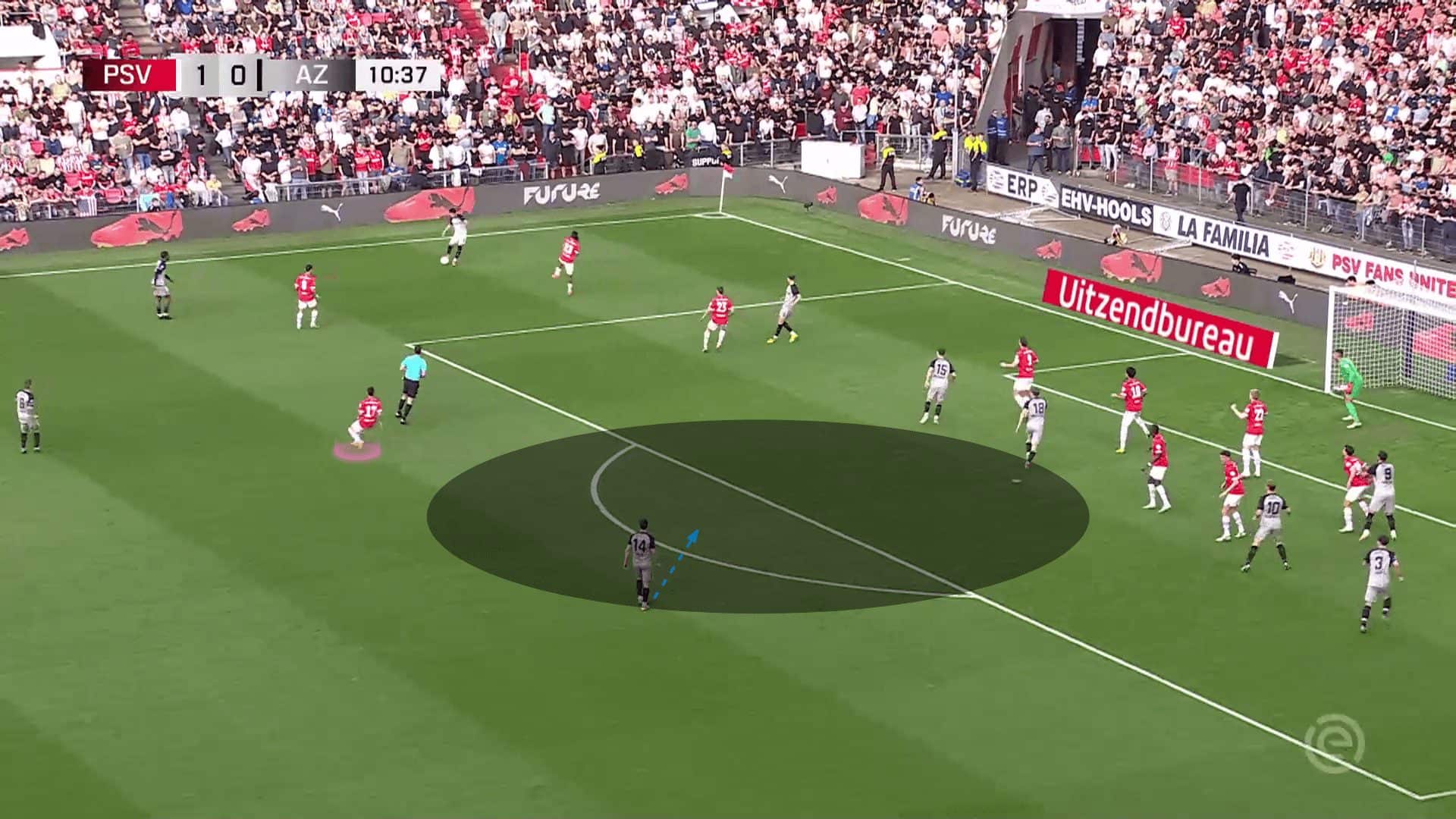
In this case below, the attacking team decides to target the rebound zone directly without short passes by only using players to fake movements at the corner of the box to drag the short and rebound defenders. We should also mention that big teams now ask this blue short-option defender to stand more inside at first, as shown, to cut this direct flat passing lane while being also not far from the short-option attacker and then go to face the attacker after the pass.

This plan was so good, but it was supposed that the yellow attacker blocked his marker, but he didn’t, so the smart marker realised the plan and went to cut the pass, as shown in the two photos below.
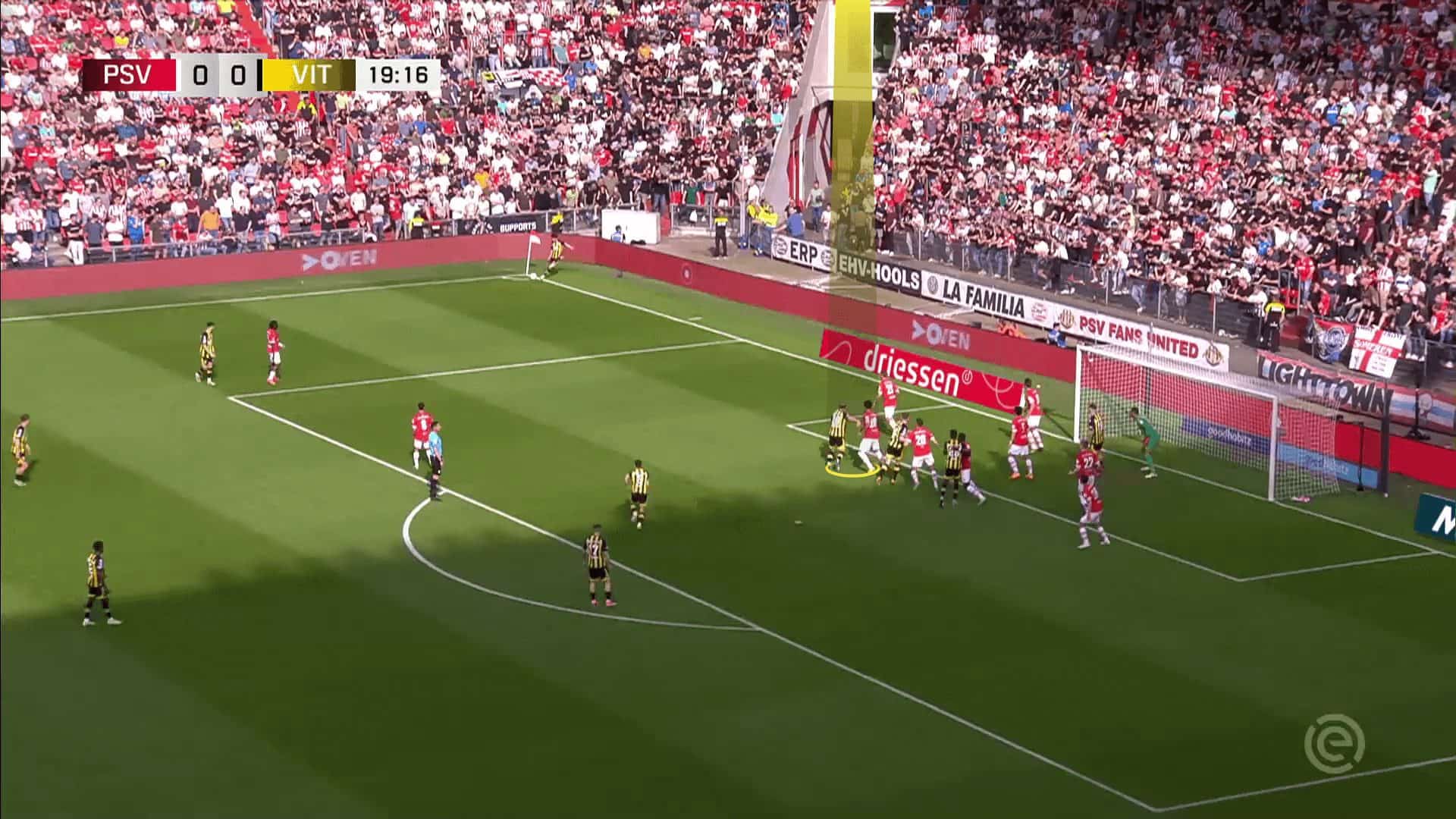
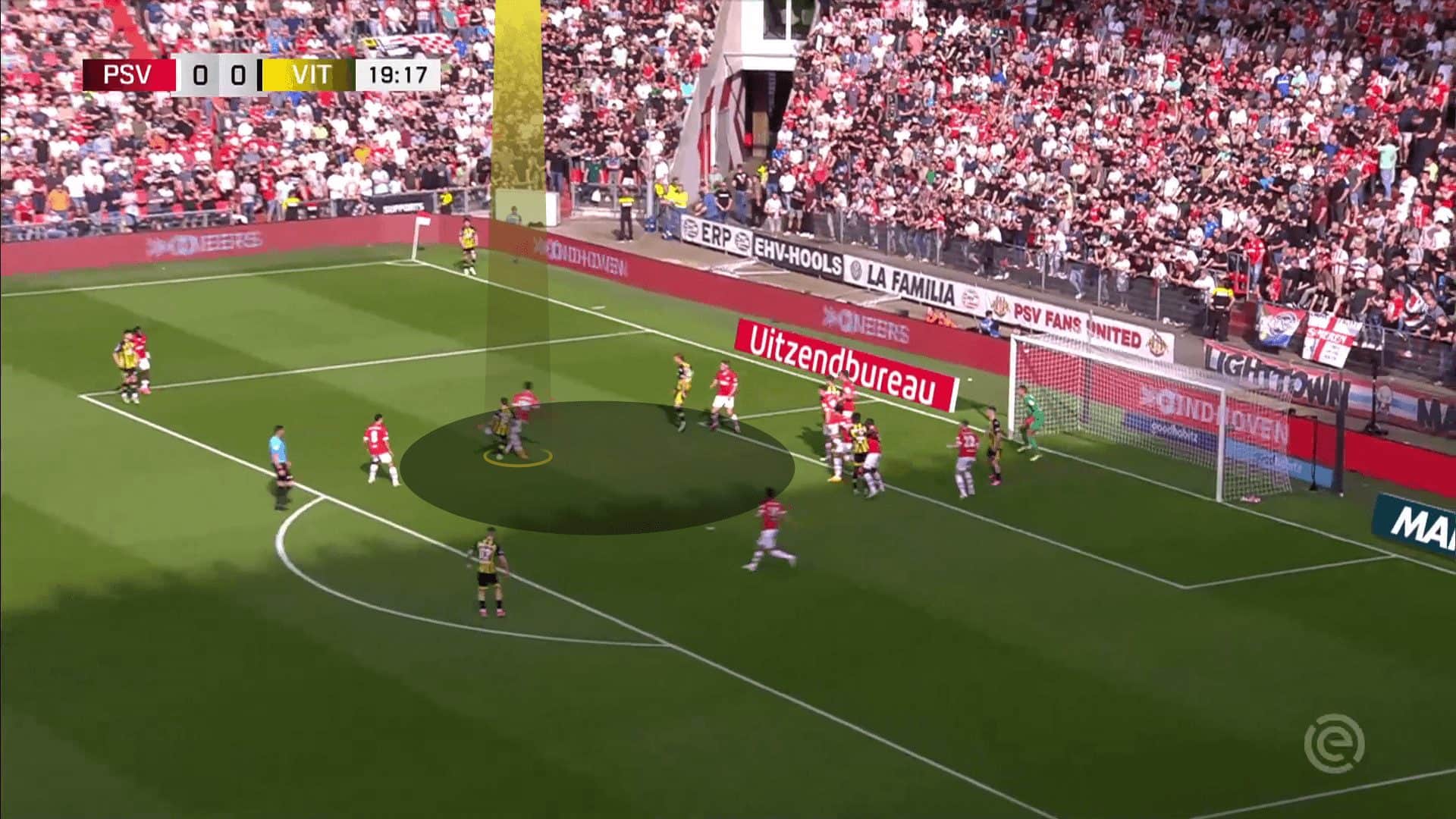
Conclusion
In this analysis, we have discussed the reasons behind the robustness of PSV Eindhoven’s defensive capabilities in set-piece situations in general and corner kicks in particular this season. These factors have contributed to making them the best defensive line in the Eredivisie this season.
In this set-piece analysis, we have scrutinised PSV Eindhoven’s defensive structure during corner kicks, rendering them the sole team in the league to not concede any goals from corner kicks. Additionally, we explored the defence’s approach to various scenarios, augmenting the opponent’s challenge. Furthermore, we have discussed potential weaknesses that could be exploited in their defensive scheme.






Comments